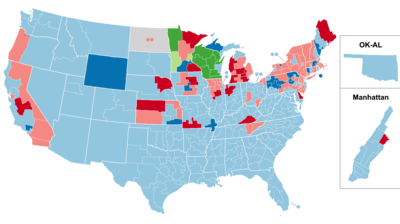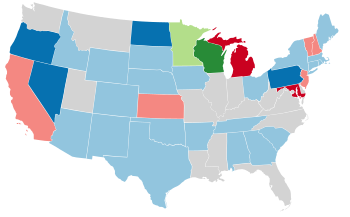| ← 1932 1933 1934 1935 1936 → Midterm elections | |
| Election day | November 6 |
|---|---|
| Incumbent president | Franklin D. Roosevelt (Democratic) |
| Next Congress | 74th |
| Senate elections | |
| Overall control | Democratic hold |
| Seats contested | 36 of 96 seats (32 Class 1 seats + 5 special elections) |
| Net seat change | Democratic +9 |
 | |
| 1934 Senate election results
Democratic gain Democratic hold | |
| House elections | |
| Overall control | Democratic hold |
| Seats contested | All 435 voting seats |
| Net seat change | Democratic +9 |
 | |
| 1934 House of Representatives election results
Democratic gain Democratic hold | |
| Gubernatorial elections | |
| Seats contested | 34 |
| Net seat change | Democratic +1 |
 | |
| 1934 gubernatorial election results
Democratic gain Democratic hold | |
The 1934 United States elections were held on November 6, 1934. The election took place in the middle of Democratic President Franklin D. Roosevelt's first term, during the Great Depression. In a historic midterm election, the Democrats built on the majorities in both houses of Congress they had won in the previous two elections.
In the House of Representatives, Roosevelt's party gained nine seats, mostly from the Republican Party. The Democrats also gained nine seats in the U.S. Senate, thereby winning a supermajority. A Progressive also unseated a Republican in the Senate. This marked the first time that an incumbent president's party did not lose seats in both houses in a midterm election, followed by 1998 and 2002. The feat of the president's party seeing net gains in both the United States Senate and the governorships would not be observed again until 2022. This was also the last midterm until 2022 in which the president's party did not lose any state legislative chambers or incumbent senators.
The election was perhaps the most successful midterm of the 20th century for the party in control of the presidency. Despite opposition from Republicans, business organizations such as the United States Chamber of Commerce, and disaffected Democrats who formed the American Liberty League, Roosevelt's New Deal policies were bolstered and his New Deal coalition was solidified. The election was critical in re-centering the Democratic Party in Northern, urban areas, as opposed to the party's traditional base in the South. Conservative Republicans also suffered major losses across the country. Future president Harry S. Truman won election as senator from Missouri during this election.
See also
- 1934 United States House of Representatives elections
- 1934 United States Senate elections
- 1934 United States gubernatorial elections
- Kelayres massacre
References
- One Class 1 seat held both a regular election and a special election in 1934. This seat is not double-counted for the total number of seats contested.
- "Statistics of the Congressional Election of November 6, 1934" (PDF). U.S. House of Reps, Office of the Clerk. Retrieved December 28, 2011.
- Busch, Andrew (1999). Horses in Midstream. University of Pittsburgh Press. pp. 138–145.
This American elections-related article is a stub. You can help Misplaced Pages by expanding it. |